文章目录
- 前言
- 1.vector的介绍及使用
- 1.1 vector的介绍
- 1.2 vector的使用
- 1.2.1 vector的定义
- 1.2.2 vector iterator 的使用
- 1.2.3 vector 空间增长问题
- 1.2.3 vector 增删查改
- 1.2.4 vector 迭代器失效问题。(重点!!!!!!)
- 1.2.5 vector 在OJ中有关的练习题
- 2.vector深度剖析及模拟实现
- 2.1 std::vector的核心框架接口的模拟实现dzj::vector
- 本文章内容后续会完善一些!!!
- 总结
前言
提示:这里可以添加本文要记录的大概内容:
C++中的vector是一个强大而灵活的动态数组容器,它提供了在运行时动态增长和收缩的能力,极大地简化了数组的管理。vector是标准模板库(STL)中的一部分,为程序员提供了高效的数据存储和操作方式。在本博客中,我们将深入介绍vector的基本用法,并进行深度剖析和模拟实现,以帮助你更好地理解和利用这一重要的C++容器。
提示:以下是本篇文章正文内容,下面案例可供参考
1.vector的介绍及使用
1.1 vector的介绍
vector文档介绍
vector是一个动态数组容器,它以模板类的形式实现,能够存储同一类型的元素。其最显著的特点之一是能够在运行时动态调整数组大小,而不需要手动管理内存。通过push_back()进行元素的追加、pop_back()进行末尾元素的删除,以及使用迭代器进行元素的遍历,vector提供了简单而强大的操作方式。
vector的内部实现采用动态数组,这意味着它能够在需要时自动分配更多的内存空间,以适应元素的增加。这种机制确保了vector的高效性,使得它适用于各种规模和类型的数据集。
参考文献:
Josuttis, N. M. (2007). The C++ Standard Library: A Tutorial and Reference (2nd Edition). Addison-Wesley.
Stroustrup, B. (2013). The C++ Programming Language (4th Edition). Addison-Wesley.
Meyers, S. (2001). Effective STL: 50 Specific Ways to Improve Your Use of the Standard Template Library. Addison-Wesley.
1.2 vector的使用
vector学习时一定要学会查看文档:vector文档介绍,vector在实际中非常的重要,在实际中我们熟悉常见的接口就可以,下面列出了哪些接口是要重点掌握的。
1.2.1 vector的定义

#define _CRT_SECURE_NO_WARNINGS 1#include <iostream>
#include <vector>
using namespace std;
int main()
{vector<int> v1;//无参构造v1.push_back(0);v1.push_back(1);v1.push_back(2);v1.push_back(3);v1.push_back(4);v1.push_back(5);v1.push_back(6);for (int i = 0; i < v1.size(); i++){cout << v1[i] << " ";}cout << endl;vector<int> v2(v1);v2.push_back(8);v2.push_back(8);v2.push_back(8);for (int i = 0; i < v2.size(); i++){cout << v2[i] << " ";}cout << endl;return 0;
}
1.2.2 vector iterator 的使用

图解:
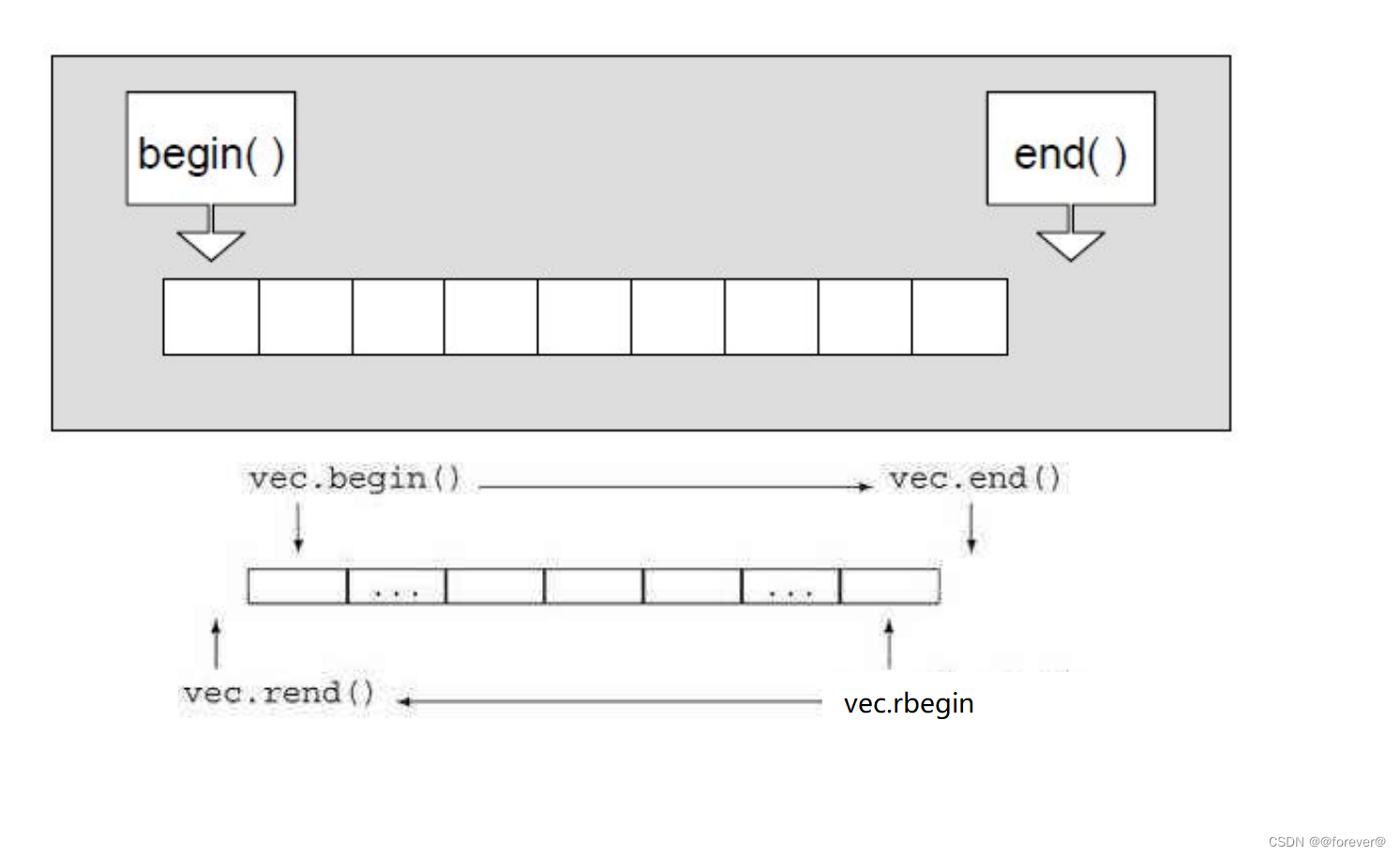
#include <iostream>
#include <vector>
using namespace std;
void Print1(const vector<int>&v)//正向遍历
{vector<int>::const_iterator it = v.begin();while (it != v.end()){cout << *it << " ";it++;}cout << endl;
}
void Print2(const vector<int>& v)//反向遍历
{vector<int>::const_reverse_iterator it = v.rbegin();while (it != v.rend()){cout << *it << " ";it++;}cout << endl;
}
int main()
{vector<int> v1;v1.push_back(1);v1.push_back(2);v1.push_back(3);v1.push_back(4);v1.push_back(5);v1.push_back(6);Print1(v1);Print2(v1);// 使用迭代器进行修改vector<int>::iterator it = v1.begin();while (it != v1.end()){*it *= 2;it++;}Print1(v1);Print2(v1);return 0;
}
1.2.3 vector 空间增长问题

-
capacity的代码在vs和g++下分别运行会发现,vs下capacity是按1.5倍增长的,g++是按2倍增长的。
这个问题经常会考察,不要固化的认为,顺序表增容都是2倍,具体增长多少是根据具体的需求定义
的。vs是PJ版本STL,g++是SGI版本STL。 -
reserve只负责开辟空间,如果确定知道需要用多少空间,reserve可以缓解vector增容的代价缺陷问题。
-
resize在开空间的同时还会进行初始化,影响size。
// vector::capacity
#include <iostream>
#include <vector>
using namespace std;
int main()
{vector<int> v;cout << "making v growing!!!!" << endl;cout << "capacity changed:" << v.capacity() << endl;for (int i = 0; i < 100; i++){v.push_back(i);if (v.size() == v.capacity())cout << "capacity changed:" << v.capacity() << endl;}return 0;
}
运行结果:
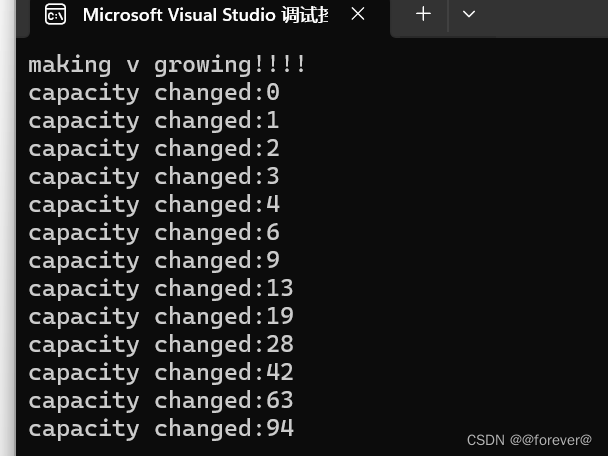
// vector::reserve
#include <iostream>
#include <vector>
using namespace std;
int main()
{vector<int> v;for (int i = 0; i < 100; i++){v.push_back(i);}cout << "size:" << v.size()<<endl;cout << "capacity:" << v.capacity()<<endl;v.reserve(200);cout << "size:" << v.size() << endl;cout << "capacity:" << v.capacity() << endl;return 0;
}
运行结果:
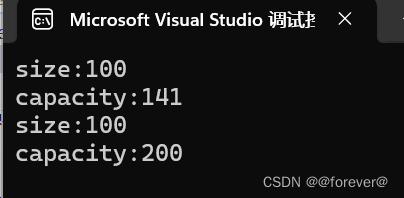
// vector::resize
#include <iostream>
#include <vector>
using namespace std;
int main()
{vector<int> v;//for (int i = 0; i < 100; i++)//{// v.push_back(i);//}cout << "size:" << v.size()<<endl;cout << "capacity:" << v.capacity()<<endl;v.resize(200);cout << "size:" << v.size() << endl;cout << "capacity:" << v.capacity() << endl;v.resize(100);cout << "size:" << v.size() << endl;cout << "capacity:" << v.capacity() << endl;v.resize(101,8);cout << "size:" << v.size() << endl;cout << "capacity:" << v.capacity() << endl;for (auto e : v){cout << e << " ";}return 0;
}
运行结果:

1.2.3 vector 增删查改
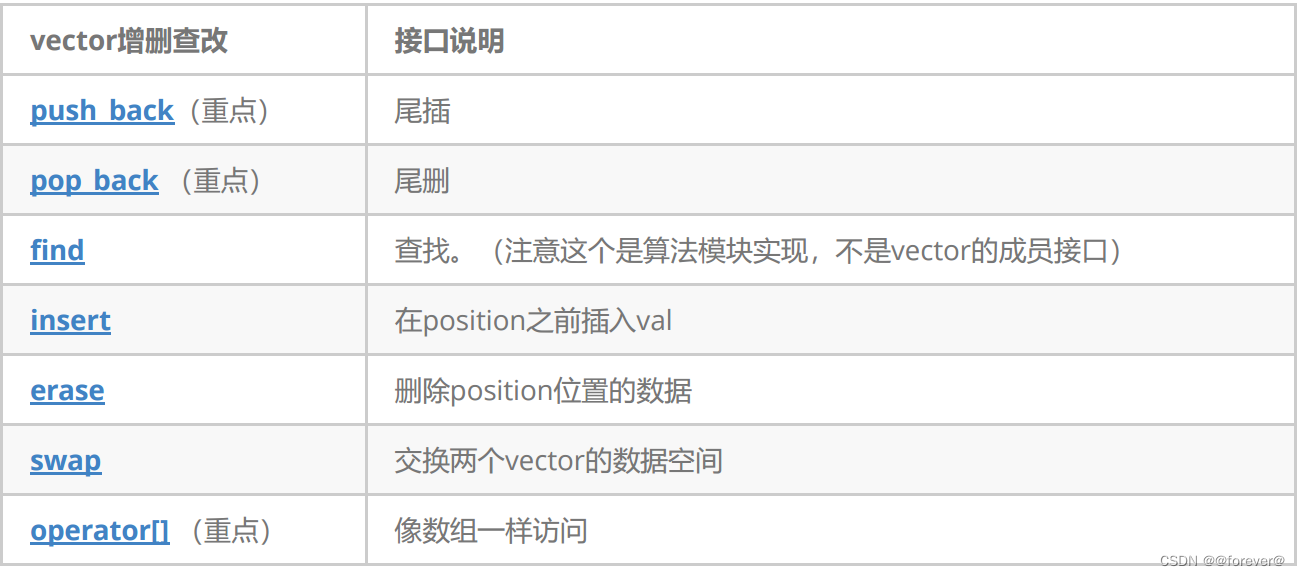
// push_back/pop_back
#include <iostream>
#include <vector>
using namespace std;
int main()
{int arr[] = { 1,2,3,4 };vector<int> v(arr, arr + sizeof(arr) / sizeof(arr[0]));v.push_back(5);v.push_back(6);vector<int>::iterator it = v.begin();while (it != v.end()){cout << *it<<" ";it++;}cout << endl;v.pop_back();v.pop_back();it = v.begin();while (it != v.end()){cout << *it << " ";it++;}return 0;
}
// push_back/pop_back
运行结果:

// find / insert / erase
#include <iostream>
#include <vector>
using namespace std;
int main()
{vector<int> v;v.push_back(1);v.push_back(2);v.push_back(3);v.push_back(4);vector<int>::iterator pos = find(v.begin(), v.end(), 3);v.insert(pos, 0);for (auto e : v){cout << e << " ";}cout << endl;pos = find(v.begin(), v.end(), 3);v.erase(pos);for (auto e : v){cout << e << " ";}return 0;
}
运行结果:

// operator[]+index 和 C++11中vector的新式for+auto的遍历
// vector使用这两种遍历方式是比较便捷的。
#include <iostream>
#include <vector>
using namespace std;
int main()
{vector<int> v = { 1,2,3,4 };//operator[]+indexfor (int i = 0; i < v.size(); i++){cout << v[i]<<" ";}cout << endl;for (int i = 0; i < v.size(); i++){v[i] *= 2;}vector<int> swapv;swapv.swap(v);for (auto e : swapv){cout << e << " ";}return 0;
}
运行结果:

1.2.4 vector 迭代器失效问题。(重点!!!)
迭代器的主要作用就是让算法能够不用关心底层数据结构,其底层实际就是一个指针,或者是对指针进行了所谓的封装,比如:vector的迭代器就是原生态指针T*。因此迭代器失效,实际就是迭代器底层对应指针所指向的空间被销毁了,而使用一块已经被释放的空间,造成的后果是程序崩溃(即如果继续使用已经失效的迭代器,程序可能会崩溃)。
对于vector可能会导致其迭代器失效的操作有
- 会引起其底层空间改变的操作,都有可能是迭代器失效,比如:resize、reserve、insert、assign、
push_back等。
#include <iostream>
#include <vector>
using namespace std;
int main()
{vector<int> v = { 1,2,3,4 };auto it = v.begin();while (it != v.end()){cout << *it << " ";++it;}v.reserve(100);while (it != v.end()){cout << *it << " ";++it;}return 0;
}
运行错误:

出错原因:以上操作,都有可能会导致vector扩容,也就是说vector底层原理旧空间被释放掉,而在打印时,it还使用的是释放之间的旧空间,在对it迭代器操作时,实际操作的是一块已经被释放的空间,而引起代码运行时崩溃。
解决方式:在以上操作完成之后,如果想要继续通过迭代器操作vector中的元素,只需给it重新赋值即可。
2. 指定位置元素的删除操作–erase
#include <iostream>
using namespace std;
#include <vector>
int main()
{int a[] = { 1, 2, 3, 4 };vector<int> v(a, a + sizeof(a) / sizeof(int));// 使用find查找3所在位置的iteratorvector<int>::iterator pos = find(v.begin(), v.end(), 3);// 删除pos位置的数据,导致pos迭代器失效。v.erase(pos);cout << *pos << endl; // 此处会导致非法访问return 0;
}erase删除pos位置元素后,pos位置之后的元素会往前搬移,没有导致底层空间的改变,理论上讲迭代器不应该会失效,但是:如果pos刚好是最后一个元素,删完之后pos刚好是end的位置,而end位置是没有元素的,那么pos就失效了。因此删除vector中任意位置上元素时,vs就认为该位置迭代器失效了。
迭代器失效解决办法:在使用前,对迭代器重新赋值即可
1.2.5 vector 在OJ中有关的练习题
- 只出现一次的数字i
- 杨辉三角OJ
- 删除排序数组中的重复项 OJ
- 只出现一次的数ii OJ
- 只出现一次的数iii OJ
- 数组中出现次数超过一半的数字 OJ
- 电话号码字母组合OJ
- 连续子数组的最大和 OJ
2.vector深度剖析及模拟实现
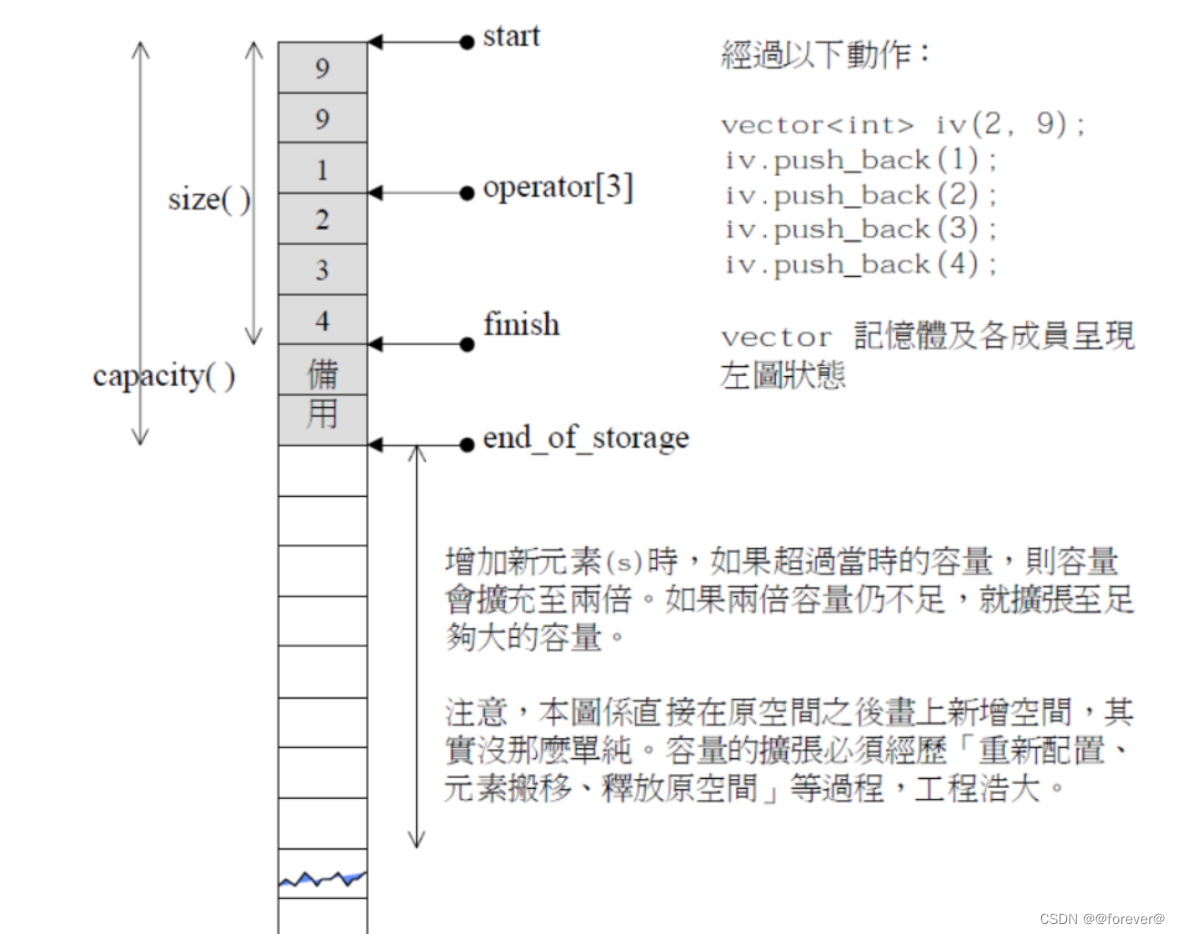
2.1 std::vector的核心框架接口的模拟实现dzj::vector
模拟实现代码
本文章内容后续会完善一些!!!
总结
通过本文的阅读,我们详细了解了C++中vector的基本概念、使用方法和一些关键特性。从动态数组的角度深度剖析了vector的内部机制,以及通过模拟实现进一步加深了对其工作原理的理解。vector的灵活性和高效性使其成为C++编程中不可或缺的工具,无论是在简单的数组操作还是复杂的数据结构中,都能展现其强大的应用价值。通过学习和研究vector,我们能够更好地优化代码、提高程序的效率,为C++编程带来更多便利。希望本文对你在使用和理解C++中的vector时有所帮助。

一:安装Centos7)





应用场景)





)





